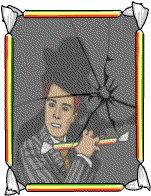'Brighton Rock' by Graham Greene
Created | Updated Jan 28, 2002

It is a busy summer in pre-World War II Brighton, UK and Charles Hale, aka Fred, aka Kolley Kibber of the Daily Messenger, has realised that they are going to kill him. While he is on the run from them, he bumps into Ida Arnold, and is with her until just before he is killed.
When Ida reads the paper to see that the recorded reason for death is natural causes, she is determined to prove otherwise. Armed with money won from a racing tip given to her by Hale, she goes on an amateur sleuthing exercise.
Meanwhile, the leader of a gang, a 17 year-old boy known as Pinkie is trying to cover his tracks with equal urgency, leading him into a deep web of duplicity, murder, and confrontations with other notorious Brighton gangsters.
There are two separate references to Brighton rock1 in the book. One is the way in which the phrase is normally used in the UK.
Rose: People change.
Ida: Oh no they don't. Look at me. I've never changed. It's like those sticks of rock: bite it all the way down, you'll still read Brighton. That's human nature.'
A phrase used in common parlance is 'He's got guilt written through him like Brighton rock', meaning that the person is obviously guilty.
The second, more macabre, reference is never made completely explicit, but Cubitt expresses that he can never look at a stick of Brighton rock, when talking about Hales' murder. Presumably the murder involved the use of a stick of rock or the rock making process.
Brighton Rock is written in a very sinister and darkly ironic style. The characters in Graham Greene's Brighton are a strange mix. Pinkie is developed to the extent that the reader can tell what he is thinking, even when he says something contradictory. Most of the other characters are stereotypes or caricatures, but for the main part they are very transient, with the exception of Ida and Rose.
Pinkie's actions in the part with Rose, Ida, Dallow and the policeman after he and Rose leave the hotel, towards the end of the book (part 7, chapter 9) are an unexpected twist, and the ending, though neither cliffhanging nor ambiguous, still ignites the reader's imagination as to what will happen afterwards.

